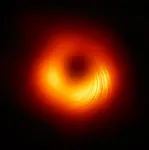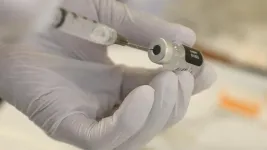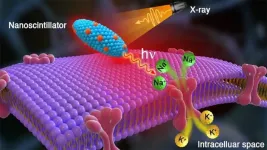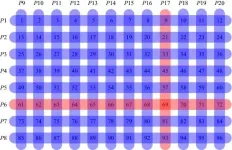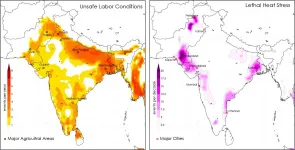(Press-News.org) Cambridge, MA - Astronomers have now obtained a new view of the supermassive black hole at the center of galaxy M87. Images released today by the Event Horizon Telescope (EHT) collaboration reveal how the black hole, some 55 million light-years away, appears in polarized light.
The image marks the first time astronomers have captured and mapped polarization, a sign of magnetic fields, so close to the edge of a black hole.
Scientists still don't understand how magnetic fields -- areas where magnetism affects how matter moves -- influence black hole activity. Do they help direct matter into the hungry mouths of black holes? Can they explain the mysterious jets of energy that extend out of the galaxy's core?
In two studies published today in the Astrophysical Journal Letters, EHT astronomers reveal their latest findings and how magnetic fields may be influencing the black hole at the center of M87.
"One of the main science drivers of the EHT is distinguishing different magnetic field configurations around the black hole," says Angelo Ricarte, a co-author and researcher at the Center for Astrophysics | Harvard & Smithsonian. "Polarization is one of the most direct probes into the magnetic field that nature provides."
The EHT collaboration has been studying the supermassive object at the heart of M87 for well over a decade. In April 2019, the team's hard work paid off when they revealed the very first image of a black hole. Since then, the scientists have delved deeper into the data, discovering that a significant fraction of the light around the M87 black hole is polarized.
Light becomes polarized when it goes through certain filters, like the lenses of polarized sunglasses, or when it is emitted in hot regions of space that are magnetized. In the same way polarized sunglasses help us see better by reducing reflections and glare from bright surfaces, astronomers can sharpen their view of the black hole by looking at how light originating from there is polarized. Specifically, polarization allows astronomers to map the magnetic field lines present around the inner edge of the black hole.
"In order to gain confidence in our analysis, we used as many as five distinct methods to calibrate the data and reconstruct polarimetric images," says Maciek Wielgus, a researcher at Harvard's Black Hole Initiative and the Center for Astrophysics (CfA) who participated in the study. "This huge team effort paid off as we found very good consistency between results obtained with all the different techniques."
These new polarized observations of the M87 black hole are key to explaining how the galaxy is able to launch energetic jets from its core, the EHT team says.
One of M87's most mysterious features is the bright jet of matter and energy that emerges from its core and extends at least 100,000 light years away. Most matter lying close to the edge of a black hole falls in. However, some of the surrounding particles escape moments before capture and are blown far out into space in the form of these jets.
Astronomers don't know how jets larger than the galaxy itself are launched from its core, nor how only certain matter falls into the black hole.
Now, with the new image of the black hole in polarized light, the team has looked directly into the region just outside the black hole where this interplay between inflowing and ejected matter occurs.
The observations provide new information about the structure of the magnetic fields just outside the black hole, revealing that only theoretical models featuring strongly magnetized gas can explain what astronomers are seeing at the event horizon.
"Magnetic fields are theorized to connect black holes to the hot plasma surrounding them," says Daniel Palumbo, a co-author and researcher at the Center for Astrophysics. "Understanding the structure of these fields is the first step in understanding how energy can be extracted from spinning black holes to produce powerful jets."
To observe the heart of the M87 galaxy, the EHT collaboration linked eight telescopes around the world, including the Smithsonian Astrophysical Observatory's Submillimeter Array, to create a virtual Earth-sized telescope. The impressive resolution obtained with the EHT is equivalent to that needed to image a credit card on the surface of the Moon.
This unprecedented resolving power allowed the team to directly observe the black hole with polarized light, revealing the presence of a structured magnetic field near the event horizon.
"This first polarized image of the black hole in M87 is just the beginning," says Dominic Pesce, CfA researcher and study co-author. "As the EHT continues to grow, future observations will refine the picture and allow us to study how the magnetic field structure changes with time."
Sheperd Doeleman, founding director of the EHT, added, "Even now we are designing a next-generation EHT that will allow us to make the first black hole movies. Stay tuned for true black hole cinema."
The EHT collaboration involves more than 300 researchers from across the globe and includes 30 scientists and engineers at the Center for Astrophysics | Harvard & Smithsonian.
INFORMATION:
About the Center for Astrophysics | Harvard & Smithsonian
The Center for Astrophysics | Harvard & Smithsonian is a collaboration between Harvard and the Smithsonian designed to ask--and ultimately answer--humanity's greatest unresolved questions about the nature of the universe. The Center for Astrophysics is headquartered in Cambridge, MA, with research facilities across the U.S. and around the world.
About the Event Horizon Telescope (EHT) Collaboration
The EHT collaboration involves more than 300 researchers from Africa, Asia, Europe, North and South America. The international collaboration is working to capture the most detailed black hole images ever obtained by creating a virtual Earth-sized telescope. Supported by considerable international investment, the EHT links existing telescopes using novel systems -- creating a fundamentally new instrument with the highest angular resolving power that has yet been achieved.
The individual telescopes involved are: ALMA, APEX, the IRAM 30-meter Telescope, the IRAM NOEMA Observatory, the James Clerk Maxwell Telescope, the Large Millimeter Telescope, the Submillimeter Array, the Submillimeter Telescope, the South Pole Telescope, the Kitt Peak Telescope and the Greenland Telescope.
The EHT consortium consists of 13 stakeholder institutions: the Academia Sinica Institute of Astronomy and Astrophysics, the University of Arizona, the Center for Astrophysics | Harvard & Smithsonian, the University of Chicago, the East Asian Observatory, Goethe-Universitaet Frankfurt, Institut de Radioastronomie Millimétrique, Large Millimeter Telescope, Max Planck Institute for Radio Astronomy, MIT Haystack Observatory, National Astronomical Observatory of Japan, Perimeter Institute for Theoretical Physics and Radboud University.
When clinical trials were conducted to determine the immunogenicity -- the ability to elicit an immune response -- for the first two vaccines marshaled against SARS-CoV-2the virus that causes COVID-19, one group was not among those included: people who have received solid organ transplants and others (such as those with autoimmune disorders) who are immunocompromised.
Now, Johns Hopkins Medicine researchers have tried to rectify that inequity, taking one of the first looks at how people who are immunocompromised respond to their first dose of one of the two mRNA vaccines -- Moderna and Pfizer-BioNTech -- currently being administered worldwide. Their findings, as published March 15, 2021, in a research letter in the END ...
DANVILLE, Pa. - A survey of Geisinger employees conducted over two weeks in December 2020 found a steady increase in intent among healthcare workers to receive the COVID-19 vaccine.
On Dec. 4, 2020, an announcement about anticipated vaccine availability was emailed to all 23,784 Geisinger employees. Recipients were asked to indicate their intention to receive a vaccine when one was available to them and the reasons for any hesitation they might have. More than two-thirds of employees responded to the survey.
Of those who completed the survey before Dec. 10, when an independent FDA advisory committee ...
News coverage of expert scientific evidence on vaccine safety is effective at increasing public acceptance of vaccines, but the positive effect is diminished when the expert message is juxtaposed with a personal narrative about real side effects, new research has found.
The study, by researchers affiliated with the Annenberg Public Policy Center (APPC) of the University of Pennsylvania and the University of Illinois, tested the effects of messages about vaccination in televised news reports. These included video clips of Dr. Anthony Fauci, director of the U.S. National Institute of Allergy and Infectious Diseases, talking about evidence supporting the value and safety of the MMR (measles, mumps and rubella) vaccine, and a mother who's refusing to vaccinate ...
Scientists make pivotal discovery of method for wireless modulation of neurons with X-rays that could improve the lives of patients with brain disorders. The X-ray source only requires a machine like that found in a dentist's office.
Many people worldwide suffer from movement-related brain disorders. Epilepsy accounts for more than 50 million; essential tremor, 40 million; and Parkinson's disease, 10 million.
Relief for some brain disorder sufferers may one day be on the way in the form of a new treatment invented by researchers from the U.S. Department of Energy's (DOE) Argonne National Laboratory and ...
Researchers Mario Guarracino the HSE Laboratory of Algorithms and Technologies for Networks Analysis in Nizhny Novgorod and Julius ?ilinskas and Algirdas Lančinskas from Vilnius University, have proposed a new method of testing for COVID-19. This group method allows results to be obtained 13 times faster as compared to individual testing of each sample. The research paper was published in the journal Scientific Reports.
The COVID-19 pandemic has already affected millions of people from over 200 countries. The rapid virus expansion demonstrated how fast such infections can spread in today's globalized world. At the beginning of the pandemic, when little was known about the virus and vaccines had not yet ...
WASHINGTON--Residents of South Asia already periodically experience heat waves at the current level of warming. But a new study projecting the amount of heat stress residents of the region will experience in the future finds with 2 degrees Celsius of warming, the population's exposure to heat stress will nearly triple.
Limiting warming to 1.5 degrees Celsius will likely reduce that impact by half, but deadly heat stress will become commonplace across South Asia, according to the new study in Geophysical Research Letters, AGU's journal publishing high-impact, short-format reports with immediate implications spanning all Earth and space sciences.
With ...
An old technique flexes its muscles
Sarcomeres are small repeating subunits of myofibrils, the long cylinders that bundle together to make the muscle fibres. Inside the sarcomeres, filaments of the proteins myosin and actin interact to generate muscle contraction and relaxation. So far, traditional experimental approaches to investigate the structure and function of muscle tissue were performed on reconstructed protein complexes or suffered from low resolution. "Electron cryo-tomography, instead, allows us to obtain detailed and artefact-free 3D images of the frozen muscle", says Raunser.
Cryo-ET was for a long time an established yet niche methodology. But recent technical advances in electron cryo-microscopy (cryo-EM) as well as the new development of ...
In the heart of black cherry's native range, including a part of the Allegheny Hardwoods that bills itself as the "Black Cherry Capital of the World," the tree's regeneration, growth and survival have all been declining for more than a decade. In a new analysis, a team of USDA Forest Service and University of Missouri scientists identify likely factors behind the tree's decline and, more significantly, conclude that black cherry may be the tip of the iceberg in terms of change in eastern deciduous forests.
Scientists used a combination of synthesis of existing research and new analyses to examine the leading hypotheses for black cherry's regeneration failure. They conclude that the two factors that are ...
Family-centered prevention programs that foster protective caregiving can buffer the negative effects of racial discrimination on young Black people, according to a study published by University of Georgia researchers.
Research shows that Black youth exposed to various levels of racial discrimination--including slurs, threats and false accusations--are at a high risk for poor mental health outcomes such as hopelessness, conduct problems, drug use and depression. After participating in family-oriented programs, high school-age adolescents who encountered high levels of racial discrimination and received supportive caregiving evinced fewer increases in conduct problems and depression/anxiety symptoms two years later.
"This research shows that ...
The high temperatures and pressures of the Earth's mantle forge carbon-rich minerals known as carbonates into diamond. But less is known about the fate of carbonates that travel even deeper underground -- depths from which no sample has ever been recovered.
Now, Michigan State University's Susannah Dorfman and her team are unearthing an answer with lab tools that mimic these extreme conditions.
"What we were interested in is, when is carbon not diamond?" added Dorfman.
In a paper recently published in Nature Communications, scientists in Dorfman's Experimental ...
